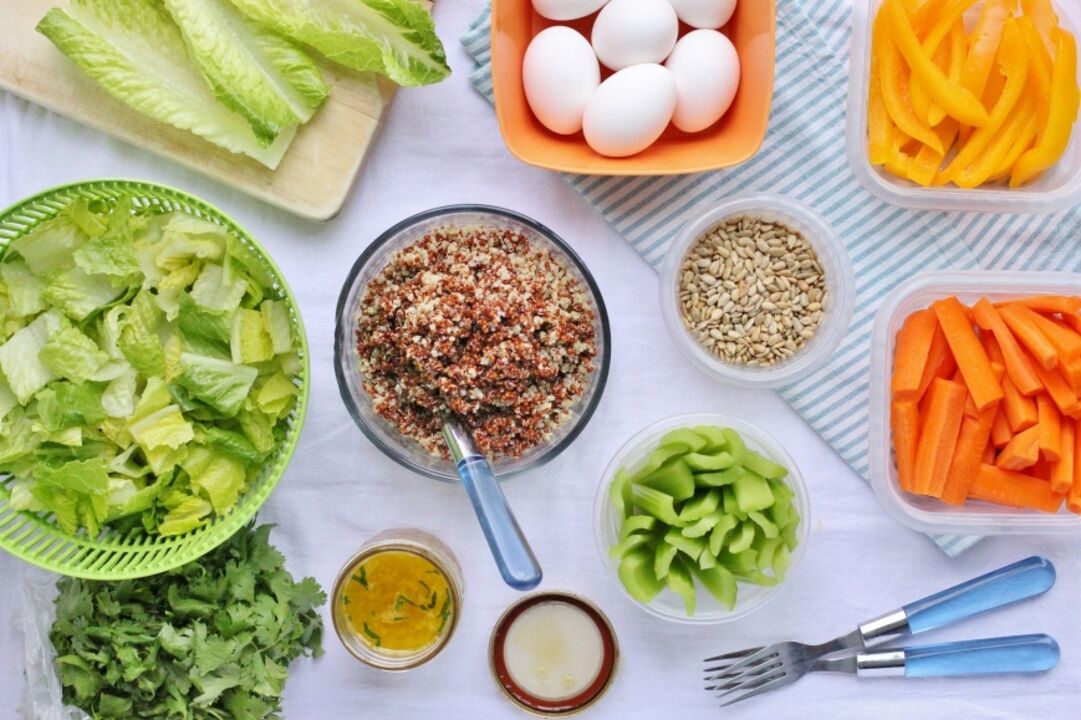
Pancreatitis is inflammation of the pancreas. Pathology occurs in acute and chronic forms. This condition has a very specific symptom: severe pain in the left side of the flanks, sometimes with band-like features, foul-smelling stools, nausea and vomiting.
The diet of pancreatitis is one of the main areas of pathological treatment. The patient’s menu depends on the general health and the period of illness. It takes months of medical nutrition.
General principles
The nutrition of pancreatic pancreatitis should be frugal. Basic principles of diet:
- Partial nutrition-must be consumed in small amounts five to six times a day;
- Dishes should be mashed, which facilitates the process of digesting food;
- The allowed cooking methods are steaming and boiling;
- Fresh vegetables and fruits are completely banned, ie. Uncooked
- The daily allowable amount of salt should not exceed 5 grams;
- Must be infusion and decoction on rosehip berries;
- The dishes on the table should be hot-hot and cold are both taboos;
- Preservation, semi-finished products, fatty/fried/high-salt foods and products are completely prohibited.
Deviation from the principles of dietary nutrition can trigger the onset of pancreatitis.
Allowed and prohibited products
In order to reduce the production of pancreatic juice and reduce the burden of inflamed glands, it is necessary to completely exclude from the patient's diet:
- Soups made with rich meat, fish and mushroom soups, as well as complex soups-cabbage soup, kimchi, borscht. Except cold food and dairy products.
- Bread-today's wheat/rye flour baked goods, shortcrust pastries and pastries, butter pancakes, tortillas.
- Fatty meat-pork, lamb, duck, goose-sausages, offal, canned food and bacon.
- a fish. Prohibited smoked and pickled fat varieties.
- Milk and lactic acid products with high fat content.
- Groats-millet, barley, wheat, corn.
- Fried eggs and hard-boiled eggs.
- Vegetables-radish, radish, garlic, pepper, eggplant, cabbage, spinach.
- Candy-jam, ice cream, fresh dates, grapes, bananas, figs.
- Spicy condiments.
- Coffee, strong tea, coffee, soda, grape juice.
- Fire-resistant fats-pork, beef, lamb.
When formulating a daily menu, it is necessary to consider the advice of a dietitian and only use approved products. it:
- Dry bread, biscuits, homemade biscuits;
- A vegetarian soup with vegetable puree-potatoes, zucchini, pumpkin, carrots-noodles, semolina or oatmeal;
- Lean meat-chicken, rabbit, turkey-in the form of steam cutlet, souffle, dumplings, beef salad;
- Low-fat fish species-pollock, carp, cod;
- Cereals-oatmeal, semolina, rice-used to make cereals, casseroles, puddings;
- Low-fat milk and lactic acid products;
- Steamed egg rolls without egg yolk;
- Vegetables-potatoes, zucchini, beets, pumpkins, broccoli, carrots, green beans;
- Fruits in the form of sweet berries and mousse, jelly, pudding, oven-baked apples, etc. ;
- Sauces-dairy products and vegetable soups (when flour is used, the latter is not fried);
- Butter and vegetable oil;
- Light lemon tea, mineral water, rose hip soup, juice diluted with water.
Acute pancreatitis diet
If we say what kind of diet is recommended for patients with acute inflammation, then this is the treatment table 5P. In the first two to four days, it is recommended that a person be completely hungry. Only liquids are allowed-rose hip decoction, Borjomi (no gas), light tea. The patient then switched to nutritional therapy. The menu is allowed to include unsalted but carbohydrate-rich dishes.
A rough list of dishes that can be included in the menu:
- Steam omelette on protein;
- Meat souffle
- Fish dumplings
- Bisque-rice and oatmeal-and vegetarian options;
- Vegetable puree
- Mashed porridge-rice, buckwheat, oatmeal;
- Apples in the form of jelly or mousse;
- Fruit drinks from wild rose berries, cranberries and black currants;
- Tea with milk
- Cottage cheese and its dishes;
- Cereal pudding.
Before going to bed, you can provide kefir, yogurt, a cup of water with a spoonful of honey, plums and raisins.
Approximately weekly menu
When formulating a week’s menu, it’s important to remember that the patient’s diet should be varied. You can use the following suggestions when developing a week-long menu for patients.
Breakfast can be served with a cooked beet salad and dried fruit compote, 150 grams of low-fat cheese and rosehip soup, steam omelet without egg yolk, light biscuit tea, grated oatmeal and berry jelly, pumpkin porridge, roseFruit drinks, cheese biscuits, rosehip broth, buckwheat mash, preserves.
The second breakfast: steamed raisin porridge, vegetable oil carrot salad, oven-baked dried apricots and apples, pumpkin carrot mash, boiled beets, sugar baked apples.
At lunch, vegetarian soups are allowed, such as borscht, cooked fish with white rice, boiled beef, cottage cheese casserole, steamed chicken steak, boiled minced pasta, and stir-fried vegetables. Snack options: allowed jelly, vegetable rolls, fresh berry jelly, fruit pudding, oven-baked potatoes, butter sandwiches and a slice of cheese, bean paste.
Dinner: Baked apple puree and low-fat yogurt, raisin porridge, raisins, vinegar sauce and yogurt, steamed cauliflower, a cup of yogurt, zucchini caviar, kefir, steamed omelet, fermented baked milk, rice pudding and low-fat yogurt.
Alternating dishes, you can create a "delicious" weekly menu that provides the patient's body with all the necessary substances, but at the same time the pancreas will receive a minimal nutrient load. You can find recipes for some dishes below.
Nutrition for the course of pancreatitis combined with gastritis or cholecystitis
If the underlying disease is accompanied by the development of cholecystitis, the allowed menu includes:
- A thick soup made from rice, oatmeal or semolina;
- Pour the porridge into puree and boil it in water. It is strictly forbidden to add milk and butter;
- Vegetable juices, preserves;
- Homemade white croutons;
- Mashed boiled meat and fish;
- Low-fat cheese.
Combining pancreatitis and gastritis, the menu should include a soup made from oats, rice and semolina. You can add egg yolk and a little butter, vegetable puree (potatoes, carrots, beets), milk or cream, steamed souffle, Meatloaf etc. Dumplings made with minced meat and fish.
The strict option is recommended only in the acute phase of the disease. After the condition stabilized, the patient switched to a diet recommended for chronic pancreatitis.
Characteristics of childhood diet
The leading principles of children's diet are fragmentation, maximum grinding, compliance with the requirements and diversity of cooking and processing. Small portions, if eaten regularly, can prevent children from feeling hungry. In this case, there is no violation of the metabolic process.

The daily calorie intake is calculated based on the child's weight and age. In the mitigation phase, the menu is allowed to include fresh vegetables and fruits (within a limited range), but the basis of the diet is cereals plus milk, minced meat dishes-chicken, turkey, vegetable soup without meat, fish-boiled orRoasted and boiled vegetables, dairy products. A small amount per day is allowed to give children marshmallows, jam, jam, jam, honey.
important!When introducing new products into the diet, it is necessary to monitor the child's condition.
recipe
We provide you with several recipes that can be used to diagnose pancreatitis.
Beef pudding
Grind boiled beef slurry (130 g) in a mixing bowl. Add semolina (10 grams), whipped egg whites, egg yolks and a little water (about 1/3 cup) to the puree. Add a few grains of salt. Grease the mold and cook the prepared minced meat in a double pot.
Fish dumplings
Grind lean fish (300 g) in a meat grinder. Grate a quarter of the dry bread, then pour milk (100 ml). Squeeze the bread, mix it with the minced meat, and add some beaten protein. Add salt and mix well. Use two spoons to form small balls, then boil them in salted water until soft. This will take about 15 minutes.
Vegetable puree soup
Cook until fully cooked potatoes (2 pieces), carrots and half a zucchini. Pour the broth into a separate bowl and use a blender to chop the vegetables until puree. Pour the broth and broth to the desired consistency and bring to a boil. Cook for 3 minutes. Add a spoonful of sour cream to the soup and serve while it is hot.
Fish pudding
The fish carcass must be divided into two fillets. Boil and sieve for the first time. Grind the second part in a meat grinder. Mix the two substances, add egg yolk, butter, and salt. rub. Sub-component mold and steam.
Egg soufflé
Grind cooked chicken in a meat grinder. Add egg yolk and butter to the minced meat. Mix well. Then gently add the whipped egg whites to the fluffy foam. Put the mass into the mold and steam it.
Banana dessert
Dissolve 2 packets of gelatin according to the instructions. Add 250 ml of natural yogurt. Steam a few bananas and peeled peaches. Place the aluminum foil on the bottom of the plastic mold. Layer desserts-biscuit crumbs, gelatin yogurt cream, banana peach puree. Alternate layers. Put the sweetener in the refrigerator to set the jelly.
Compliance with the principles of pancreatitis diet and nutrition is a prerequisite for achieving lasting and long-term relief. The menu for adults and children with pancreatitis can be very diverse and fully meet all the needs of the body through appropriate development methods.














































































